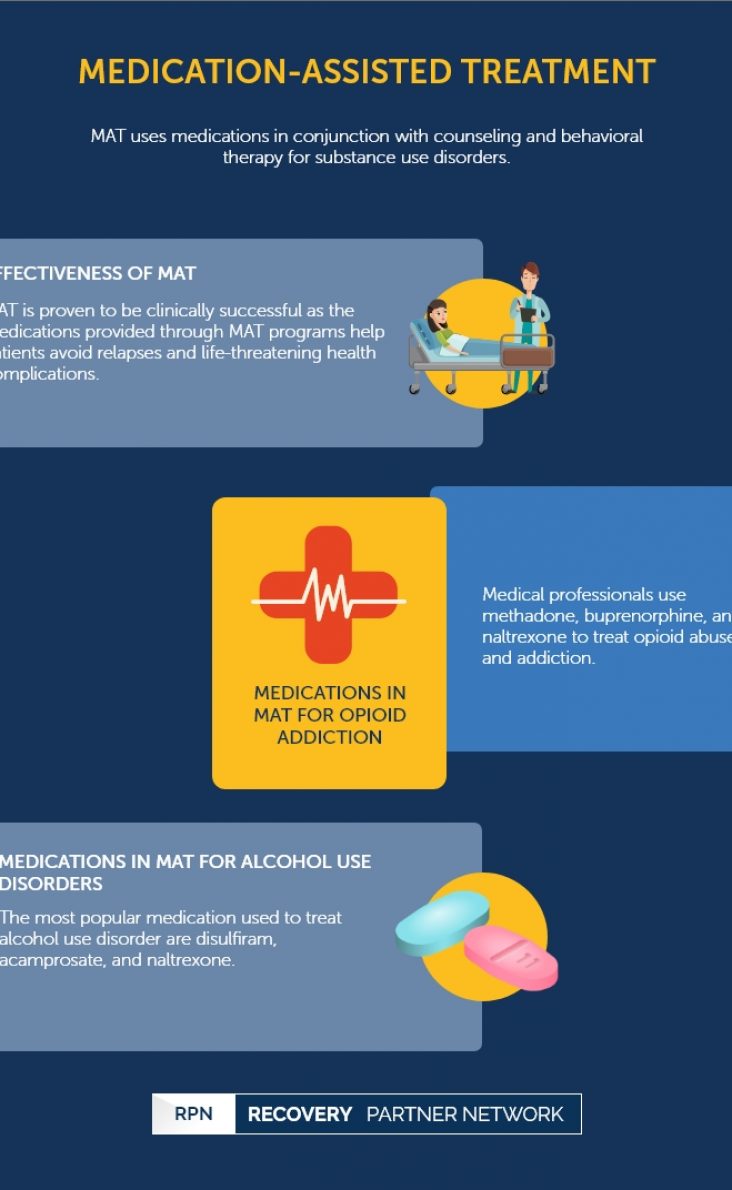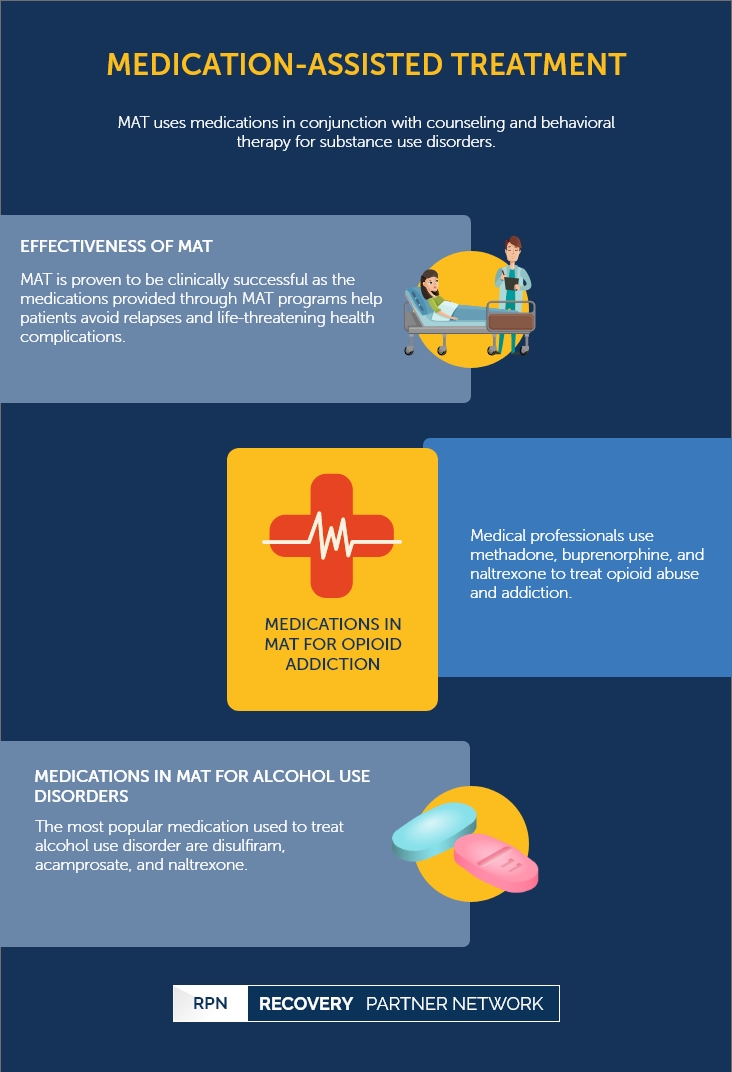MAT uses medications in conjunction with counseling and behavioral therapy for substance use disorders.
Medication-Assisted Treatment (MAT)
Medication-Assisted Treatment (MAT) | Table of Contents
What is Medication-Assisted Treatment (MAT)?
Medication-Assisted Treatment (MAT) uses FDA approved medications combined with counseling and behavioral therapies to successfully treat and stabilize individuals dealing with addictions. MAT is generally used to treat opioid abuse, such as heroin and opiate-containing prescription pain relievers. MAT treatment programs are clinically oriented and customized to suit the needs of each individual.
The prescribed medications in MAT helps with:
- Readjusting and normalizing brain chemistry
- Inhibit the euphoric effects of alcohol and opioids
- Ease physiological cravings
- Regulate body functions without the adverse effects of the addictive substance
FAQ
Medication-assisted treatment (MAT) uses a combination of medication, counseling, and behavioral therapies to effectively treat opioid use disorder (OUD).
Research indicates that medication-assisted therapy provides better outcomes for patients struggling with opioid use disorder by decreasing the risk of relapse significantly.
Opioid Treatment Programs (OTPs)
Opioid treatment programs (OTPs) include MAT for individuals diagnosed with an opioid use disorder. OTP also offers various treatments to minimize, eradicate, or avoid the consumption of illegal drugs, possible criminal activities, and infectious disease transmissions. OTP aims to enhance the quality of life of those who seek treatment.
In addition to prescription medicine, federal law mandates patients seeking care in an OTP receive medical, counseling, occupational, educational, and other assessment and recovery services. The law permits MAT practitioners to offer care and services in several environments, including hospitals, correctional facilities, offices, and remote clinics. As of 2020, it has been recorded that OTP is located in every US state and territories except Wyoming and Guam.
Effectiveness of MAT
MAT has proved to be clinically successful as it greatly reduces or alleviates severe withdrawal symptoms during detoxification. Medications provided through MAT programs help patients avoid relapses and life-threatening health complications. MAT offers a combination of medications along with a comprehensive behavioral treatment plan designed specifically for each individual seeking treatment. MAT also provides support services that address most patients’ needs. The end goal of MAT is an effective recovery, which also includes the ability to follow a life of self-direction.
This approach to treatment has been shown to:
- Enhance recovery of patients.
- Boost treatment retention.
- Reduces illegal use of opioids and other unlawful activities by individuals struggling with substance use disorders.
- Improve the capability of patients to obtain and maintain jobs.
- Increase birth results among pregnant women struggling with substance use disorders.
- Help reduce a person’s risk of contracting HIV or hepatitis C by minimizing relapse potential.
MAT is unfortunately underused tremendously. For example, as per SAMHSA’s Treatment Episode Data Set (TEDS) 2002-2010, the percentage of heroin admissions with treatment and recovery plans that included receiving medication-assisted opioid therapy declined from 35 percent in 2002 to 28 percent in 2010. The poor acceptance of these evidence-based treatment alternatives for alcohol and opioid abuse is partly due to false assumptions regarding replacing one drug with another. Discrimination against MAT patients is also another reason, despite state and federal laws prohibiting it. Other factors include a lack of training for physicians and negative views on MAT within communities and among medical professionals.
To prevent such discrimination and promote MAT as a viable treatment option, the Substance Abuse and Mental Health Services Administration (SAMHSA) created a brochure designed to support patients with MAT and raise public awareness. Under the Confidentiality Regulation, 42 Code of Federal Regulations (CFR) 2, personal health records related to drug use and alcohol addiction must be handled with a higher degree of confidentiality compared to other medical information.
FAQ
- What are the major components of medication assisted treatment?
- What is the main goal of medication assisted treatment for opioid use disorder?
- Is medication-assisted treatment evidence-based?
MAT consists of four key components such as pharmacological therapy, community educational interventions, coordination/integration of substance use disorder treatment and other medical or psychological treatments, as well as psychosocial services and interventions.
MAT’s primary purpose is to help patients sustain long-term recovery through the use of medications in conjunction with therapies and counseling. MAT helps patients recover by alleviating severe withdrawal symptoms and manage cravings.
MAT is an evidence-based approach to treating opioid use disorders.
Medications in MAT for Opioid Addiction
Methadone, buprenorphine, and naltrexone are used by medical professionals to treat opioid abuse and short-acting opioid addiction such as heroin, morphine, and codeine, as well as semi-synthetic drugs, such as oxycodone and hydrocodone. Individuals can take medications used in MAT safely for months, years, or even for life. However, patients who wish to discontinue MAT medications must seek professional and medical assistance before doing so.
Methadone reduces opioid cravings and opioid withdrawal symptoms. Methadone is a medication approved by the FDA to manage opioid use disorder through medication-assisted treatment programs. Methadone is safe and efficient when used as prescribed. The medication helps individuals achieve and maintain recovery and reclaim meaningful and active lives. Methadone is available in the form of liquid, powder, and diskettes. Women who are breastfeeding or pregnant must notify their treatment provider before taking methadone.
Buprenorphine decreases opioid cravings and withdrawals, as well as the effects of other opioids. Buprenorphine is a partial agonist of opioids. This medication can generate effects like euphoria or respiratory depression at low to moderate doses. However, these effects are weaker than full-opioid agonists, such as heroin and methadone.
FDA has approved the following buprenorphine drugs for opioid use disorders (OUD):
- Generic Buprenorphine/naloxone sublingual tablets
- Buprenorphine sublingual tablets (Subutex)
- Buprenorphine/naloxone sublingual films (Suboxone)
- Buprenorphine/naloxone) sublingual tablets (Zubsolv)
- Buprenorphine/naloxone buccal film (Bunavail)
- Buprenorphine implants (Probuphine)
- Buprenorphine extended-release injection (Sublocade)
Intramuscular extended-release naltrexone is a medication permitted by FDA to manage both OUD and alcohol use disorder (AUD) through a medication-assisted treatment program. Naltrexone can be recommended and administered by any physician licensed to prescribe medications and is available as a pill for alcoholism or as an intramuscular extended-release Injection for alcohol and opioid abuse.
Naltrexone works differently in treating opioid abuse compared to methadone and buprenorphine. If an individual under naltrexone relapses, naltrexone blocks the drug’s sedative effects and diminishes the euphoric sensations generated by these drugs.
Medications in MAT for Alcohol Use Disorders
The most popular drugs used to treat alcohol use disorder are disulfiram, acamprosate, and naltrexone. Although none of these medications are considered a cure for alcoholism, they help minimize the chances of a relapse and help achieve long term recovery.
Disulfiram is a medication that is used by medical professionals to treat chronic alcoholism. It is most effective in individuals who have already undergone detoxification or are in the initial stage of abstinence. This drug comes in a tablet form, which is consumed once a day. Disulfiram should never be consumed while being intoxicated and should not be consumed after drinking alcohol for at least 12 hours.
Acamprosate is a medication that is prescribed once an individual quits drinking alcohol and would like to avoid drinking in the future. Although this drug helps discourage individuals from drinking, it does not prevent withdrawal symptoms after consuming alcohol. Acamprosate loses its effectiveness if an individual continues to consume alcohol, illicit drugs, or prescription drug while on the medication. Generally, acamprosate is prescribed on the fifth day of abstinence and achieves maximum efficiency in five to eight days. This medication comes in a tablet form that is consumed three times a day, preferably every day at a fixed time.
Naltrexone blocks the euphoric effects and the feelings of intoxication of alcohol. This helps individuals with alcohol addiction gradually lower their drinking levels enough to stay in recovery or prevent relapses.
Recovery Partner Network
We aim to educate and empower. If you feel our library of resources does not cover your specific need, reach out to us, and we would be happy to help.
STATISTICS
© Copyright 2025


